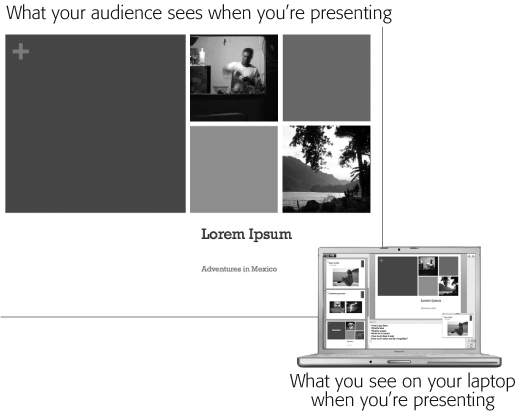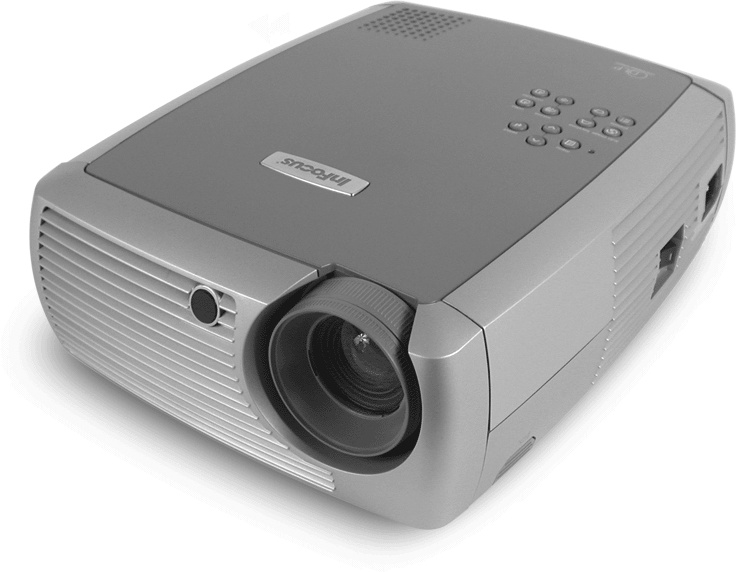If you’re lucky, you’ll have complete control over every aspect of your presentation—including the computer, the projector, and all the other technical bits and pieces that are required.
Often, though, you’ll be using others’ equipment; plugging your laptop into a video projector at a conference; or just showing up with your presentation on a CD and running it on someone else’s computer. When the equipment isn’t your own, you have to be more flexible and ready to improvise.
You can run PowerPoint 2008 presentations on any of the current crop of MacBooks and MacBook Pros. Older laptops, especially G4 machines, are apt to have some difficulty presenting some of the more complex animation and transition affects. To get the best performance, use JPEG’s for image files, MP3s for audio files, and don’t use 3-D or shadow effects. Presentations intended for single viewers—like self-paced lessons—are well-suited to a desktop computer. But for most presentations, the portability of a laptop makes it the computer of choice.
Depending on the size of your audience, the type of room you’re in—and the size of your budget—you can show your PowerPoint presentations right on your laptop, on an external monitor, or with a video projector.
If you’re presenting to a group and you’re able to dim the lights, a projector is usually your best bet. The video projector market is booming, fueled by home theater buffs and computerized presenters like you. Prices are falling and new models are emerging weekly—resulting in a bewildering array of projectors to choose from. Prices start at about $500, but plan on at least $800 as a minimum price for a bright, high-resolution projector.
Figure 15-2. While the audience sees your slides on the big screen, your MacBook can help you keep your place in the presentation—and keep you from looking over your shoulder to see what’s on the screen. It can display the current slide and the next slide, your slide notes, and a clock or timer telling you either elapsed time or the remaining time in your presentation. If you need to rush to the finish, or go back to the beginning, the thumbnails on the left let you jump to any slide in the presentation. You’ll learn how to display these onscreen features in the next chapter.
Tip
If you’re not familiar with video projectors and you’re considering dropping $1000 or more to purchase one, you should really find a store where you can compare the models you’re interested in under lighting conditions that are similar to the way you’ll be using it. Get a head start on your comparison shopping by visiting www.projectorcentral.com, where you can read reviews and buyer guides, and post projector-related questions on their forum.
Figure 15-3. When your audience starts bumping heads as a result of leaning in to look at your laptop screen, it’s time to consider a video projector. The variety of sizes and prices available is growing rapidly, and though the prices are coming down, it’s still a big investment. Consider renting a projector if you need one infrequently. Then when you’re ready to buy, you’ll better understand the features you need (and by then you’ll get even more for your money).
If the thought of shopping for a new digital camera gives you a frisson of excitement, then deciphering the specs of video projectors should be right up your alley. There are three basic types of video projectors: LCD (liquid crystal display), DLP (digital light processing), and LCOS (liquid crystal on silicon). Most of the time the projector type is less important than its key specifications. After you figure out your budget and how large and heavy a projector you’re willing to carry around, consider these important criteria:
Resolution. This figure represents the number of pixels the projector can display, and should match your computer’s video output. Most projectors are designated SVGA (800 x 600 pixels) or XGA (1,024 x 768 pixels). More pixels gives you a sharper screen image and—surprise, surprise—cost more. All Macbooks and MacBook Pros can output either of these resolutions.
Brightness. Like slide or movie projectors, video projectors produce an image on the screen by projecting it with a very bright light. The intensity of that light is measured in ANSI lumens. Methods of measuring lumens vary from manufacturer to manufacturer, so consider these specifications as only ballpark figures. Less than 1000 lumens is fine when projecting on smaller screens or in darkened rooms, but will be too dim on larger screens or under brighter lighting conditions. 1500 lumens is a good minimum for rooms that can’t be darkened—but you’ll only know for sure by trying out a projector under similar projection conditions.
Inputs. Projectors designed for a home theater system may feature only S-video and composite video inputs. Mac laptops can output in this format—if it’s your only option. Projectors designed for computer presentations have either a VGA connector, a DVI connector, or both (and quite possibly S-video and composite video inputs as well). Connect your laptop using the VGA connection or, if available, the DVI connection. Some newer, higher-end projectors have only a DVI connection.
If you don’t find yourself giving PowerPoint presentations at the drop of a hat, you may be better off renting a projector. Look in the Yellow Pages under Audio-Visual Equipment to find a local outlet. And if you don’t have a local AV house, you can even rent equipment by mail (or least, by UPS). When you rent, you can take advantage of the newest technology, get a projector that suits the requirements for your particular presentation space, and let somebody else worry about repairs and bulb replacement.
The screen is an often overlooked element of projection quality. A poor screen—or wall—can make the best projector’s image look terrible. There are as many different kinds of screens available as there are projectors, starting at about $100 for rollup screens. Any screen will be better than a regular wall, although you can get very good results in a darkened room with a smooth, matte white painted wall.
Projection screens come in a wide variety of surfaces which provide varying amounts of gain, enhanced brightness attained by directing the light from the projector back to the audience instead of allowing it to scatter in all directions. High-gain screens have a lower viewing angle. In other words, they reflect more light to viewers closer to the centerline of the screen. A matte white screen—or a flat, white wall—provides the widest viewing angle and the least gain.
Using a remote control for your PowerPoint presentation gives you the freedom to move away from your laptop—and you’ll appear much more professional when you’re not reaching for the computer to advance each slide. Even if you like the security of the podium and want to keep an eye on your speaker’s notes on your PowerBook’s screen, by using a remote control you can advance slides while gesturing or with your hand in your pocket. When you’re ready to break free of the podium, the remote lets you stroll the stage or amble through the audience—while still controlling your presentation.
Figure 15-4. Plug this remote’s USB receiver into your computer and you needn’t be tied to the lectern to change slides. Whether you’re seated at a table or mingling with the audience, a handheld remote lets you spend more time connecting with your audience, and less time connected to your computer.
If you’ve got a MacBook or MacBook Pro, you’ve already got the remote control that came with your laptop, intended mostly as a way to control Apple’s Front Row feature. The Apple Remote communicates with your computer via infrared (just like a TV remote)—so you do have to point it at your computer and it won’t function if it’s in your pocket.
Tip
Be sure to pair your Apple Remote with your computer so it can be controlled only by that particular remote. Otherwise, a jokester in the audience could control your presentation with his Apple Remote. To create this bond of remote-control monogamy, make sure you’re logged in as an Admin user. Then, from a few inches away, point the remote at the IR sensor on the front of the computer, and press and hold the Menu and Next/Fast-forward buttons simultaneously for five seconds. (If you ever need to un-pair, choose![]() → System Preferences → Security and click Unpair.)
→ System Preferences → Security and click Unpair.)
Most other remote controls use RF (radio frequency) to communicate with a receiver plugged into your laptop’s USB port. Because they use radio waves there’s no need to point the remote control at your laptop. But when you do need to point something out on one of your slides, some remotes have a built-in laser pointer, so you don’t have to fumble with more than one handheld device.
Some remotes can also function as a mouse, or control your iTunes and DVD playback. However, when you’re in the midst of the presentation you may find that simpler is better—and the only buttons you really need are forward and backward. The winner of the simplicity competition is the Power Presenter RF, sporting only forward and back buttons and a laser pointer (www.powerremote.com). The sleek and popular Keyspan Presentation Remote (or its more powerful sibling, the Presentation Remote Pro) adds a mouse controller to the mix (www.keyspan.com).
There’s also the possibility that you already own a RF remote control—albeit one with lots of buttons: your cell phone. Salling Clicker software lets you use certain Bluetooth mobile phones and PDAs to control your computer. If your Mac has built-in Bluetooth—or you’ve added a Bluetooth adapter—then this $20 piece of software is all you need to turn your phone into a remote control for PowerPoint and many other programs. Learn more at www.salling.com.



